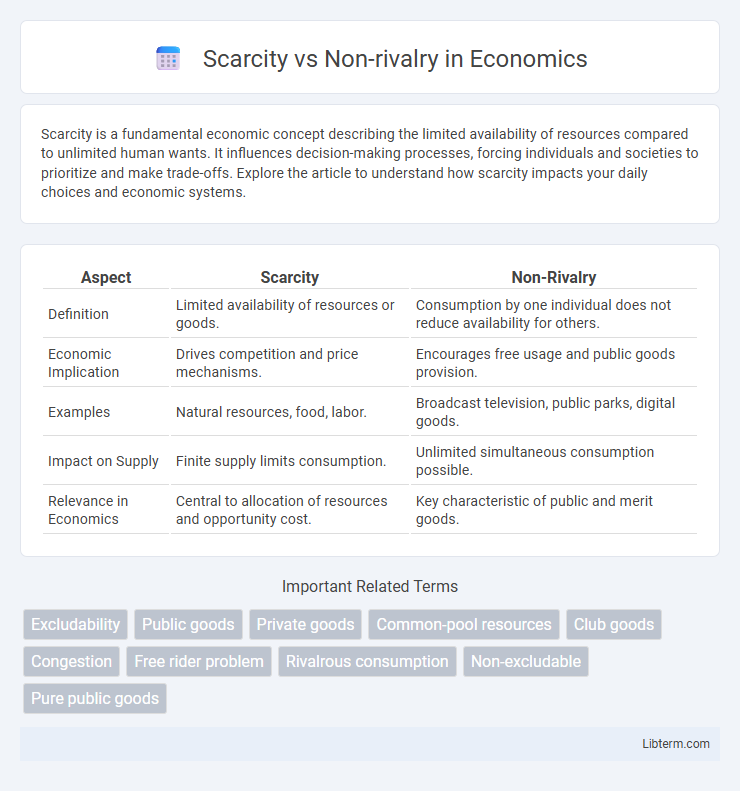Scarcity is a fundamental economic concept describing the limited availability of resources compared to unlimited human wants. It influences decision-making processes, forcing individuals and societies to prioritize and make trade-offs. Explore the article to understand how scarcity impacts your daily choices and economic systems.
Table of Comparison
| Aspect | Scarcity | Non-Rivalry |
|---|---|---|
| Definition | Limited availability of resources or goods. | Consumption by one individual does not reduce availability for others. |
| Economic Implication | Drives competition and price mechanisms. | Encourages free usage and public goods provision. |
| Examples | Natural resources, food, labor. | Broadcast television, public parks, digital goods. |
| Impact on Supply | Finite supply limits consumption. | Unlimited simultaneous consumption possible. |
| Relevance in Economics | Central to allocation of resources and opportunity cost. | Key characteristic of public and merit goods. |
Understanding Scarcity: The Basics
Scarcity refers to the limited availability of resources, which makes them valuable since demand often exceeds supply. Non-rivalry describes goods that can be consumed by multiple people without reducing availability, such as digital content or public radio. Understanding scarcity is crucial for effective resource allocation and economic decision-making, as it highlights the need to prioritize uses where resources generate the highest benefit.
Defining Non-Rivalry in Economics
Non-rivalry in economics refers to a characteristic of certain goods where one person's consumption does not diminish the availability for others, exemplified by public goods like national defense or digital content. Unlike scarce resources, non-rivalrous goods can be consumed simultaneously by multiple individuals without depletion, enhancing efficiency in resource allocation. This concept contrasts with scarcity, where the consumption of a resource by one individual reduces its availability for others, driving the need for economic choices and prioritization.
Key Differences Between Scarce and Non-Rival Goods
Scarce goods have limited availability, meaning consumption by one individual reduces the amount available for others, while non-rival goods can be consumed by multiple individuals simultaneously without depletion. Scarcity typically leads to competition and pricing mechanisms, whereas non-rival goods, such as public goods like national defense or clean air, often require government provision or collective funding due to their non-excludable nature. Understanding these key differences influences economic policies, resource allocation, and market behavior regarding goods distribution.
Real-World Examples of Scarcity
Scarcity occurs when resources like clean water, rare minerals, or arable land have limited availability and cannot be consumed simultaneously by multiple users, highlighting their exclusive usage. For instance, freshwater in drought-prone regions demonstrates scarcity as overuse by agriculture reduces availability for human consumption. In contrast, non-rivalrous goods such as digital software or public broadcasts can be used by many individuals simultaneously without depletion.
Non-Rival Goods in Everyday Life
Non-rival goods are resources or products that can be consumed by multiple people simultaneously without diminishing their availability, such as public parks, broadcast television, and online content. These goods exemplify non-scarcity, enabling widespread access without competition over use, contrasting sharply with scarce, rival goods like food or clothing. Understanding non-rival goods in everyday life highlights the importance of digital infrastructure and shared public services in modern economies.
The Role of Scarcity in Market Pricing
Scarcity plays a crucial role in market pricing by limiting the availability of goods and services, thereby driving up their prices when demand exceeds supply. Non-rivalrous goods, such as digital products or public services, do not diminish in availability with consumption, often leading to lower marginal costs and price challenges. Understanding the impact of scarcity helps economists and businesses set prices that reflect true market value and resource allocation efficiency.
How Non-Rivalry Influences Consumption
Non-rivalry in economics means one person's consumption of a good does not reduce its availability for others, as seen in public goods like digital content or national defense. This characteristic allows simultaneous use by multiple consumers without depletion, fostering widespread accessibility and increased overall utility. Non-rivalrous goods encourage shared consumption, reducing exclusionary practices and enhancing collective benefits in markets and social systems.
Economic Implications of Scarcity vs Non-Rivalry
Scarcity in economics signifies limited resources, compelling choices and driving up opportunity costs as demand surpasses supply, which influences market prices and allocative efficiency. Non-rivalry describes goods whose consumption by one individual does not reduce availability for others, often leading to underproduction in private markets due to free-rider problems. Understanding the economic implications of scarcity versus non-rivalry is critical for policy design, particularly in managing public goods and addressing resource allocation inefficiencies.
Public Goods: Where Scarcity and Non-Rivalry Intersect
Public goods are characterized by non-rivalry, meaning one individual's consumption does not reduce availability for others, while scarcity limits their supply due to finite resources. Scarcity in public goods arises when demand exceeds capacity, yet non-rivalry ensures multiple users benefit simultaneously without depletion. Examples include clean air, national defense, and public broadcasting, where utility persists despite widespread consumption.
Policy Approaches for Managing Scarcity and Non-Rival Assets
Effective policy approaches for managing scarcity focus on allocation methods such as pricing mechanisms, quotas, and tradable permits to ensure sustainable use of finite resources. In contrast, non-rival assets like public goods require policies promoting open access, funding for maintenance, and preventing congestion through regulation. Differentiating strategies between rivalrous goods, which suffer from depletion, and non-rivalrous goods, which allow simultaneous use without diminishing value, is essential for efficient resource management and maximizing social welfare.
Scarcity Infographic

 libterm.com
libterm.com